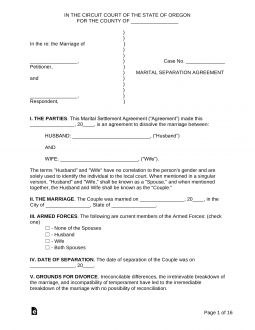Updated August 29, 2023
An Oregon marital settlement agreement is a divorce tool executed by two (2) spouses who are willing to settle certain matters relating to the dissolution of their marriage. A settlement agreement might not be required by the court to obtain a divorce decree, but it can help in speeding up the divorce proceedings in some instances. Once this agreement is signed, it is legally binding; however, this doesn’t mean a divorce action is commenced, or a divorce decree is ordered. A divorce can only be finalized by the judge, which occurs when one or both of the spouses have filed for divorce and completed the necessary paperwork. Matters that are addressed in the document include spousal support (alimony), child support, child custody, property distribution, and the division of liability/debt. While not necessary, it is recommended that spouses seek legal counsel or a mediator when completing a marital settlement agreement.
Table of Contents |
Divorce Laws
Statutes – Vol. 3, Chapter 107, Sections 005-452
Alimony (§ 107.105(1)(d)) – The court may order alimony in the form of transitional spousal support, compensatory spousal support, and/or spousal maintenance for an indefinite period. They will take into consideration any number of factors they deem relevant, including, but not limited to, the following determinants:
- Duration of the marriage
- Age of the parties
- The health of the parties, including physical, mental, and emotional
- Standard of living established during the marriage
- Relative income and earning capacity
- Training and employment skills (of the party seeking maintenance)
- Work experience (of the party seeking maintenance)
- Financial needs and resources
- Tax consequences of the support award
- Custodial and child support responsibilities
Alimony Calculator – calculators.law
Child Support (§ 25.275) – Child support is determined using the formula created by the Division of Child Support of the Department of Justice. The income of both parents will be used in calculating child support, as will other considerations as relayed in the guidelines of the Oregon Administrative Rules § 137-050.
Child Support Calculator – Oregon Department of Justice Child Support
Division of Property (§ 107.105(1)(e)) – When it comes to dividing property in a divorce action, the courts consider all property to be marital property, the only exception being property acquired by gift, i.e., through bequest, inheritance, or any other gift. The court will divide the property fairly and equitably, as per the law of equitable distribution, as opposed to dividing the property evenly.
Grounds for Divorce (§ 107.025) – Oregon is a no-fault divorce state; therefore, neither party needs to prove the other committed any wrongdoing. Either party can simply claim the marriage has broken down due to irreconcilable differences.
Interim Support (§ 107.095(1)) – Once an action for divorce is underway, the court may order temporary support from one party to the other for the purposes of enabling them to prosecute or defend the action and to care for themselves and their minor children from the marriage, if applicable.
Residency (§ 107.075) – At least one (1) spouse must have lived in the state for six (6) months prior to either party filing a divorce action.
Separation – There is no statute that requires separation before a divorce action can be filed.
Divorce Forms
- Where to File – County Circuit Court
- Filing Fee – $301
- How Long Does it Take? Two (2) to six (6) weeks
Uncontested Divorce with No Children:
- Petition for Dissolution of Marriage
- Summons for Family Law Case
- Record of Dissolution of Marriage
- Notice of Statutory Restraining Order Preventing Dissipation of Assets
- Confidential Information Form (CIF)
- Uniform Support Declaration (USD)
- Notice of Filing of CIF
- Statement of Assets and Liabilities
- Acceptance of Service
- Certificate of Service
- Ex Parte Motion for Order of Default and Declaration in Support
- Order on Motion for Default
- Declaration in Support of Judgment
- General Judgment of Dissolution of Marriage
Uncontested Divorce With Children:
- Petition for Dissolution of Marriage
- Summons for Family Law Case
- Record of Dissolution of Marriage
- Notice of Statutory Restraining Order Preventing Dissipation of Assets
- Confidential Information Form (CIF)
- Uniform Support Declaration (USD)
- Notice of Filing of CIF
- Statement of Assets and Liabilities
- Child Support Worksheet
- Parenting Plan
- Acceptance of Service
- Certificate of Service
- Waiver of Appearance and Consent to Entry of Judgment
- Ex Parte Motion for Order of Default and Declaration in Support
- Order on Motion for Default
- Declaration in Support of Judgment
- General Judgment of Dissolution of Marriage
How to File for Divorce in Oregon (8 steps)
- Complete Forms
- File Forms
- Serve Respondent
- Respondent’s Answer
- Default Judgment (If Applicable)
- Trial and Judgment (Contested Divorce)
- Agreement and Judgment (Uncontested)
- Name Change (If Applicable)
1. Complete Forms

In Oregon, a divorce action, also called a dissolution of marriage, starts with one spouse filing for divorce in the county in which either spouse has resided for at least six (6) months. For the purposes of the proceedings, the spouse filing the divorce is called the “petitioner” and the other spouse the “respondent.” The process will be slightly different depending on whether or not there are children involved. The first step for the petitioner is to complete the following forms:
- Petition for Dissolution of Marriage (Without Children | With Children)
- Summons for Family Law Case
- Record of Dissolution of Marriage
- Notice of Statutory Restraining Order Preventing Dissipation of Assets
- Confidential Information Form (CIF)
- Uniform Support Declaration (USD) (only if the child and/or spousal support is requested)
- Notice of Filing of CIF
- Statement of Assets and Liabilities
If the divorce involves minor children (children under the age of eighteen (18)), they must also complete a Parenting Plan and a Child Support Worksheet. Furthermore, if there are adult children to the marriage ages eighteen (18), nineteen (19), or twenty (20), they are technically a party to the case, and they have the legal right to participate. If the adult child is in school, they may seek child support from either or both parents.
2. File Forms
3. Serve Respondent
- Petition
- Summons
- Notice of Filing of CIF
- Notice of Statutory Restraining Order Preventing Dissipation of Assets
- Statement of Assets and Liabilities
- USD (if applicable)
- Parenting Plan (if applicable)
To serve all documents on the respondent, the petitioner can use one (1) of the following options:
- Acceptance of Service: The easiest way to serve divorce papers is by delivering them to the respondent personally and having them sign an Acceptance of Service. This concludes the service process but does not necessarily mean the respondent agrees with all issues mentioned in the petition. The Acceptance of Service must be filed with the court.
- Formal Service: The petitioner can hire the sheriff’s office, a process server, or a competent non-party to the case over the age of eighteen (18) to deliver the documents to the respondent. The server must complete a Certificate of Service to file with the court clerk after serving the respondent by one (1) of the following methods:
- Personal: The server personally delivers the documents to the respondent.
- Substituted: The server personally delivers the documents to someone at the respondent’s residence over the age of fourteen (14). The server must also send copies of the documents to the respondent’s residence by first-class mail.
- Office: The server leaves the documents with a person in charge of the respondent (employer, boss, manager, etc.) at their normal workplace. The server must also send copies of the documents to the respondent’s residence by first-class mail.
- Mail: The server mails the documents to the respondent’s residence or workplace by first class mail and by certified mail (receipt requested), and the respondent signs for them.
All the abovementioned service options apply to any adult children of the marriage. However, adult children can choose not to participate in the case by signing a Waiver of Further Appearance and Consent to Entry of Judgment after being served by the petitioner.
4. Respondent’s Answer
5. Default Judgment (If Applicable)

When the respondent does not file their response within the thirty-day period, the petitioner can complete and file the following documents with the court:
- Ex Parte Motion for Order of Default and Declaration in Support
- Order on Motion for Default
- Declaration in Support of Judgment
- General Judgment of Dissolution of Marriage
A default judgment does not require a hearing. The court clerk will hand over all necessary documents to the judge for review. If the judge accepts all issues mentioned in the petition, they will sign the General Judgment of Dissolution of Marriage.
6. Trial and Judgment (Contested Divorce)
7. Agreement and Judgment (Uncontested)
8. Name Change (If Applicable)

If a request by either party was made to revert to their maiden name, the judge will (in almost all cases) approve this request.


